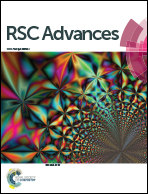Facile synthesis of nickel–cobalt sulfide/reduced graphene oxide hybrid with enhanced capacitive performance†
Abstract
A uniform hybrid with nickel–cobalt sulfide (NiCo2S4) nanoparticles attached on reduced graphene oxide (RGO) nanosheets is fabricated through a facile one-pot refluxing method. NiCo2S4 nanoparticles with sizes of several nanometers uniformly disperse on the surface of RGO sheets, and the electrochemical properties of the resulting NiCo2S4/RGO hybrids are investigated by using them as electrode materials for a supercapacitor. The NiCo2S4/RGO hybrids deliver a maximum specific capacitance of 1526 F g−1 at the current density of 1.0 A g−1, and a high rate capability, retaining 1109 F g−1 at a high current density of 20 A g−1. Moreover, after 2000 charge–discharge cycles at the current density of 10 A g−1, 83% of the initial capacitance is maintained, indicating a good cycling stability. The enhanced capacitive performance can be attributed to the synergistic effect between NiCo2S4 nanoparticles and RGO, in which RGO can provide conductive channels and serve as an ideal support matrix. The facile synthesis and the remarkable capacitive performance of the NiCo2S4/RGO hybrid make it a promising candidate for electrode materials in electrochemical energy conversion/storage devices.


 Please wait while we load your content...
Please wait while we load your content...